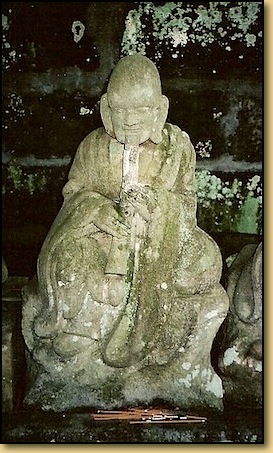
LESSONS and WORKSHOPS...-... THE BASICS...-... REPERTOIRE
LESSONS and WORKSHOPS
Individual lessons
Lessons are individual in face to face,
but collective sessions to work on the basics or the repertoire can happen if it fits the group.
Workshops
Yearly workshops can be proposed by the Eu-KSK group (Jim Franklin, Horacio Curti, Véronique Piron)
within 2 or 3 days in a European country.
European Shakuhachi Summerschool
This is a summer event lasting 4 days, organized by the European Shakuhachi Society, ESS, in a European country. It gathers the European Shakuhachi community and all its different schools with shakuhachi, koto and shamisen teachers invited from Japan and Europe. It gathers from 50 to 60 participants every year.
Learning shakuhachi in partly made in a oral way and by using the traditional notation
normally used for the repertoire and which uses a part of the Japanese syllabary "katakana",
but no preliminary knowledge of music and its writing are necessary to approach this instrument.

THE BASICS
(look to shakuhachi)
Breathing and its development
The shakuhachi, having a specially wide embouchure, needs an important volume of air and the development and support of the air stream; in this way it gives the opportunity to approach various techniques of breath.
Production and development of the sound
Looking natural and simple in appearance, the bamboo offers an incredible sound, a perceptible and usable sound pallet at any level we are; and more than a flute, its complex tone color is getting closer to that of a reed instrument.
Specific techniques
Of simple making, being a flute with 5 holes, the shakuhachi develops simple but also sophisticated techniques:
finger hittings, glissandi, sounds of breath, movements of the head, etc...
This basic work can be a purpose in itself and be developed
over a very long period for those who wish it.
It is also a good base to approach improvisation simply.
(rakun statue in temple Kita-In, Kawagoe, Japan)
REPERTOIRE

It is the original repertoire, emblematic of the shakuhachi, dated from the 13th century and that developed in the context of Zen Buddhism, here in the style transmitted by famous Katsuya Yokoyama ( 1934-2010 ) and his school (KSK: Kokusai Shakuhachi Kenshukan, " International Institute of Shakuhachi "), also called sometimes dokyoku, and which includes a part of the kinko style repertoire.
Almost all of the pieces of this repertoire work with the rhythm of the breath without any
rhythmic pulsation, in a rather meditative style, and is approachable this way by all, and represents
the most appreciated repertoire of the shakuhachi. Right from the start, an introduction to this style
is proposed to beginners, by using short pieces specially adapted for this level.
三曲 Sankyoku...(literally "trio", shamisen-koto-shakuhachi, of written tradition)
It is a borrowed repertoire ( gai - kyoku ) from the classical ensemble music Jiuta or called citizen music, singing (often poems of old anthologies) accompanied by the shamisen and the koto, symbolic of the Edo period ( circa 1600-1868 ). The relationship to time and to tempo is here important, and the shakuhachi which imitates the way of playing of the stringed instruments uses specific melodic and rhythmic patterns.
Learning this repertoire, if it is approached, is first occuring in solo and can be practiced that way,
but it is during workshops that the practice with koto and shamisen players can happen.
民謡 Minyô (mostly oral tradition)
The music of popular tradition, specific to each region, where, in a melodic and expressive syle, the shakuhachi imitates singing and its special vocal techniques. which he(it) accompanies traditionally with other instruments (most of the time the shamisen with or without percussions).
Songs of fishermen, sailors, farmers, songs according to the lunar calendar, lullabies, etc.
This repertoire approached from the start, allows an immediate melodic approach of the instrument.
These 3 styles represent the roots of the language of the shakuhachi, and have fed the styles which succeed them historically: the modern shin-kyoku (or the revival of the 1930s); and the contemporary gendai-kyoku, composers' new pieces which develop an expressive aspect more in a western style and explore timbres and playing techniques of the instrument.